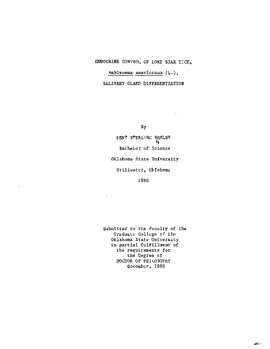| dc.contributor.advisor | Bantle, John | |
| dc.contributor.author | Shelby, Kent Sterling | |
| dc.date.accessioned | 2015-11-09T22:23:50Z | |
| dc.date.available | 2015-11-09T22:23:50Z | |
| dc.date.issued | 1988-12 | |
| dc.identifier.uri | https://hdl.handle.net/11244/21312 | |
| dc.description.abstract | Salivary glands of female Amblyomma americanum (L.) are stimulated to differentiate by attachment to a host, subsequent feeding and mating. Incorporation of [3H]uridine into ribosomal and transfer RNAs as well as the synthesis of poly(A+)mRNA and protein parallel the pattern of increasing enzymatic activity and secretory ability of the glands. Unfed ticks contained 3.5+0.47 ng poly(A+)mRNA/gland pr. By the second day of feeding this had increased more than 5-fold. The greatest amount of poly(A+)mRNA found in rapid-feeding phase females (body wt)100 mg) was 370+80 ng/gland pr. Poly(A+)mRNA mass doubles on the final day of feeding, just as the ticks exceeded 100 mg in wt. Ticks attached 1 to 10 days had increasingly greater amounts of salivary monosomes, 60 and 40S ribosomal subunits and polysomes. Polysomal mass/gland pr also attained its maximum above 100 mg tick wt at the slow/rapid-feeding phase boundary; exceeding by 20 times that of unfed ticks. Degenerating glands from replete ticks continued to synthesize protein. In vitro incorporation of [3H]leucine was greatest within 24 hr of attachment. Fluorographs of [3H]leucine labeled protein showed that mating caused a drop in incorporation after the 4th day of feeding. Glands from unmated females attached the same number of days continued to incorporate [3H]leucine at higher levels than those from mated females. | |
| dc.format | application/pdf | |
| dc.language | en_US | |
| dc.rights | Copyright is held by the author who has granted the Oklahoma State University Library the non-exclusive right to share this material in its institutional repository. Contact Digital Library Services at lib-dls@okstate.edu or 405-744-9161 for the permission policy on the use, reproduction or distribution of this material. | |
| dc.title | Endocrine control of lone star tick, Amblyomma americanum (L.), salivary gland differentiation | |
| dc.contributor.committeeMember | Sauer, John | |
| dc.contributor.committeeMember | Essenberg, Richard | |
| dc.contributor.committeeMember | Melcher, Ulrich | |
| dc.contributor.committeeMember | Burks, Bud | |
| osu.filename | Thesis-1988D-S544e.pdf | |
| osu.accesstype | Open Access | |
| dc.type.genre | Dissertation | |
| dc.type.material | Text | |
| thesis.degree.discipline | Zoology | |
| thesis.degree.grantor | Oklahoma State University | |
